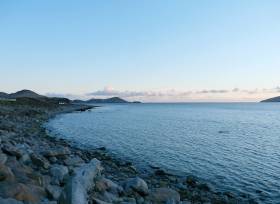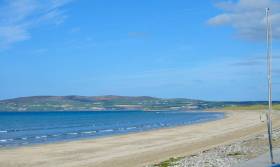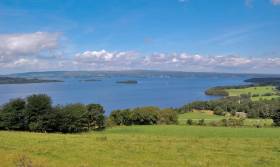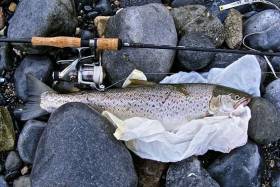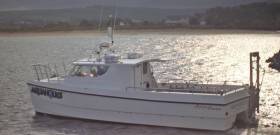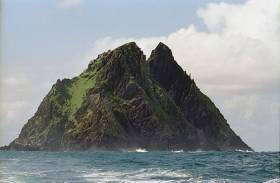Displaying items by tag: tourism
Waterville Locals & Business Invited To Info Event On Opportunities In Angling Tourism
#Tourism - Waterville Lakes and Rivers Trust is hosting an information event on opportunities in angling tourism for business owners and the public in Waterville and surrounding areas later this month.
The event, which takes place at The Sea Lodge in Waterville, Co Kerry on Thursday 27 April at 7.30pm, will focus on sharing results from a recent economic survey carried out in Waterville among angling tourists to the area.
The research reveals some key opportunities for business and service providers in the locality.
The Waterville Anglers Survey queried 207 anglers visiting the area and found that on average, angling visitors spend €644 per fishing trip, or €114 per day.
The impact of this expenditure is far reaching across the local community, with €451 spent on non-angling items such as accommodation, restaurants/cafés and groceries, and €193 of angling expenditure on items such as angling guides, boat hire and equipment.
This daily spend of anglers in Waterville (€114) far exceeds the spending of non-angling visitors to Ireland. Fáilte Ireland’s Tourism Facts Report 2015 cites expenditure of non-angling visitors and holiday makers at €68 and €89 respectively per person per day in 2015.
The research, which was carried out by Inland Fisheries Ireland with Waterville Lakes and River Trust, highlights the significant recreational and economic value of the fisheries resource to the area.
Rod Robinson, spokesperson for Waterville Lakes and Trust, said: “Waterville is a popular destination for anglers and this research shows us the huge economic contribution they make to Waterville and the potential opportunity which exists for the community.
“We are inviting the public, business owners and tourist operators to come along and hear more so that together we can grow our offering around the fisheries amenity.”
Suzanne Campion, head of business development at Inland Fisheries Ireland, added: “We know at a national level that the fisheries resource contributes €836 million to the Irish economy annually but this local research also tells us that there is significant value of angling tourists to this community.
“We also note that the research once more confirms that angling visitors spend more than non-angling tourists and that they visit outside of the traditional tourist season, supporting local businesses and jobs while doing so.”
The information event is open to all to attend. For more details, contact Rod Robinson at Waterville Lakes and Trust via email at [email protected].
Banna Tops List of TripAdvisor’s Best Irish Beaches
#TopBeaches - Banna Strand in Co Kerry has topped TripAdvisor’s list of Ireland’s best beaches.
The stretch of sand on Tralee Bay takes the top spot in the annual table from second-placed Inchydoney in Co Cork, which had been the travel website user’s favourite for the last three years running.
West coast beaches dominate the top 10, and the Kingdom claims most of all, taking third (Derrynane), fourth (Inch Beach) and sixth places (Coymeenoole).
But strands in Sligo, Connemara, Donegal and Curracloe in Co Wexford also made the cut, as Independent.ie reports.
Midlands Waterways To Get ‘Slow Tourism’ Push In 2017
#Tourism - Boating in the Midlands’ waterways will be the focus of a major tourism push this year, as The Irish Times reports.
Fáilte Ireland’s new ‘slow tourism’ initiative will concentrate on promoting existing walking and cycling greenways and ‘blueway’ cruising routes in Midlands counties south from Lough Allen on the upper Shannon.
Minister of State for Tourism Patrick O’Donovan announced the new marketing plans in his address to the Irish Hotels Federation conference in Kilkenny yesterday (Tuesday 28 February).
“We have had the Wild Atlantic Way, Ireland’s Ancient East, and now we are working on a development plan for the Lakelands,” he said.
The Irish Times has more on the story HERE.
Leitrim Angling Project Shares In Rural Waterways Stimulus Package
#Angling - Following the announcement of an €800,000 stimulus package for economic development on Ireland’s waterways, Inland Fisheries Ireland (IFI) has released details of Leitrim’s share to develop angling in Ballinamore.
An award of €100,000 from the Department of Arts, Heritage, Regional, Rural and Gaeltacht Affairs under the REDZ (Rural Economic Development Zone) Initiative will go to improving access to angling in Ballinamore with a view to developing tourism in the Lakelands region, as proposed by Leitrim County Council with support from IFI.
The project involves the development of angling infrastructure at Garadice and Kiltybarden Lakes, venues noted for match angling and currently annual hosts of the World Pairs Angling Championships. The €100,000 grant will upgrade the facilities at these locations to draw other national and international competitions to the area.
The angling facility will also be accessible to wheelchair users and will have a special area dedicated to youth angling.
In total the project will cost around €125,000, with the rest of the funding provided by IFI (€21,200) and Leitrim County Council (€3,800).
Frank Curran, chief executive of Leitrim County Council, said: “We are delighted with the approval of the funding for the Rural Economic Development Zone for Ballinamore and Carrigallen area which is focusing on the angling sector.
“Angling is an extremely important economic driver for this area made possible by the excellent fishing lakes in the locality along with a well-known, international reputation. Ballinamore/Carrigallen has been host to numerous angling competitions such as the World Pairs and the Dutch King of Clubs.
“Leitrim County Council looks forward to working with the local trade and Inland Fisheries Ireland in the delivery of this project in the coming months.”
IFI head of business development Suzanne Campion added: “Our fisheries resource is precious from a recreational and economic viewpoint. We are committed to ensuring that Ireland uses the resource to its best potential in a conservation focused manner and we are delighted to secure this funding for Leitrim.
“Anglers already enjoy the great fishing and beautiful scenery available at Ballinamore and this facility will make access to angling easier and allow the area to cater for several large and international angling competitions.
“Investment in angling development is crucial if we are to help attract visitors to rural areas. We know that angling visitors spend considerable time in an area when they identify with it as an angling destination. Anglers use several services and business in an area when visiting such as accommodation, restaurants, shops as well as boat hire and equipment rental.
“We look forward to working with our partners, Leitrim County Council and the community, in enhancing Ballinamore as a top angling destination.”
The Ballinamore project will form part of IFI’s National Strategy for Angling Development (NSAD), a comprehensive national framework for the development of Ireland’s angling resource.
The strategy aims to deliver a wide-ranging set of investments, innovations and promotions over the coming five years, to ensure that Ireland’s fish stocks and angling infrastructure are protected and enhanced for both their economic value and recreational benefit to the communities and visitors they serve across Ireland.
Poaching Threat To Connemara Angling Tourism
#Angling - Poaching is a direct threat to efforts to revive salmon and trout angling and associated tourism in Connemara, a local business has warned.
Brian Curran of Lough Corrib-based Ireland West Angling told the Connacht Tribune that poachers are doing “untold damage to rehabilitation efforts” in Spiddal and environs, following a recent conviction of a local man for unlawful netting on the Boluisce River.
Such illegal practices disturb the painstaking work of Inland Fisheries Ireland staff and local registered fisheries to clear obstructions and place spawning gravel to aid fish in their migration.
The story comes weeks after Northern Irish anglers expressed their own concerns over poaching and pollution in the Carlingford and Lough Foyle areas, as previously reported on Afloat.ie.
Causeway Coast Diving Firm Splashes Out On New Boat To Boost Business
#Diving - A new commercial catamaran is part of a Portstewart-based diving firm’s efforts to compete with popular dive tourism destinations abroad, as the News Letter reports.
Diving is ‘big business’ for the Aquaholics Dive Centre, which provides services for big-name film and TV productions such as Game of Thrones alongside its training, sea safari and diving holiday offerings.
And it’s the tourism that such visibility brings to Northern Ireland that the company aims to capture, with its new boat just the ticket to explore more of the Causeway Coast’s impressive diving sites.
The News Letter has more on the story HERE.
Skellig Ring Makes Top 10 World Travel Regions
#SkelligRing - The Skellig Ring in Co Kerry features in Lonely Planet’s top 10 regions for globetrotters to explore on 2017.
“Ireland’s most charismatically wild and emerald stretch of coastline,” as the popular travel guide’s Best in Travel report puts it, rounds out a list that includes such breathtaking destinations as French Polynesia, Chilean Patagonia, mountainous New Zealand and the Azores.
And unsurprisingly, the biggest draw to this corner of the Wild Atlantic Way is the majestic Skellig Michael, set for another bumper tourism year in 2017 on the back of its inclusion in the new Star Wars movie series.
Lough Neagh Joins List Of Top 100 Sustainable Destinations
#Tourism - Lough Neagh joins an exclusive list of 100 ‘sustainable destinations’ after its success in a global tourism competition this week.
As the News Letter reports, the largest inland waterway in the island of Ireland was put forward for evaluation by the Green Destinations Top 100 team, which narrowed down 150 nominees around the world to those taking sustainability most seriously for locals and tourists alike.
Eimear Kearney of the Lough Neagh Partnership was on hand to accept the prestigious designation at the Global Sustainability Competition in Ljubljana, Slovenia.
“For Lough Neagh to be named among the 100 greenest of destinations worldwide is a real achievement,” she said.
The partnership has recently launched a new scheme to improve habitats for protected bird species around the lough, according to BBC News.
The good news for Lough Neagh comes in the same week that a number of maritime tourism operators were featured at the 2016 Irish Responsible Tourism Awards, as previously reported on Afloat.ie.
Marine Wildlife & Lighthouses Feature in Responsible Tourism Awards
Maritime tourism operators featured at the 2016 Irish Responsible Tourism Awards announced at a ceremony yesterday in Dublin.
In the best for Natural Heritage Tourism category, a silver award went to Sea Synergy Marine Awareness & Activity Centre (Co. Kerry). The marine interpretive centre located in the heart of the coastal village Waterville displays interactive displays on Ireland's marine life, such as turtles, sharks, swordfish, bones from whales and dolphins.
In the best Innovation in Responsible Tourism, the Great Lighthouses of Ireland was another Silver award winner. The tourism initiative, is a new all-island tourism initiative, developed by the Commissioners of Irish Lights and features twelve lighthouses in breathtaking coastal locations. The project offers visitors from home and abroad the chance to visit or stay in a lighthouse, to find out about their history, to appreciate the spectacular natural world around them.
The awards are a response to demand from the Irish trade for a new type of awards showcasing the best in Irish responsible tourism. The 2016 Irish Responsible Tourism Awards aim to inspire replication, to excite media interest, to encourage competition and celebration from across the tourism industry on the island of Ireland.
The Irish Responsible Tourism Awards are part of a growing family of worldwide responsible tourism awards which are all linked to the World Responsible Tourism Awards, founded by responsibletravel.com. Winners of each of the categories will be longlisted for the World Responsible Tourism Awards - a great opportunity for the Irish trade to raise international awareness.
The shortlist for the awards, which attracted entries from almost every county in Ireland, was announced in early September following assessment by a panel of industry experts chaired by international responsible tourism expert Professor Harold Goodwin. The award categories and the winners of the Silver & Gold awards are:
Best for Natural Heritage Tourism
· GOLD: Doolin Cave (Co. Clare)
· SILVER: Burren Nature Sanctuary (Co. Galway)
· SILVER: Sea Synergy Marine Awareness & Activity Centre (Co. Kerry)
Best for Accessible & Inclusive Tourism
· GOLD: Gleneagle Hotel Group (Co. Kerry)
· SILVER: Mobility Mojo
Best Local Authority Initiative for Responsible Tourism
· GOLD: Lough Muckno - Monaghan County Council
· SILVER: Westport Smarter Travel Bike Buffet - Mayo County Council
Best Tourism Accommodation for Local Sourcing
· GOLD (joint): Sea View House (Co. Clare) and Fuchsia Lane Farm Holiday Cottages (Co. Tipperary)
· SILVER: Hotel Doolin (Co. Clare)
Best Destination for Responsible Tourism
· GOLD: Mulranny (Co. Mayo)
· SILVER: Inishbofin Island (Co. Galway)
· SILVER: Sheep’s Head Way (Co. Cork)
Best Innovation in Responsible Tourism
· GOLD: The Blackfriary Community Heritage and Archaeology Project (Co. Meath)
· SILVER: Great Lighthouses of Ireland
Overall Winner: Mulranny (Co. Mayo)
Judges for the awards include:
Catherine Mack (responsibletravel.com)
Kevin Griffin (DIT tourism lecturer and former-EDEN awards judge)
Paddy Mathews (Fáilte Ireland)
Annabel Fitzgerald (Irish Water & formerly Coastal Programmes Manager An Taisce)
Mark Henry (Central Marketing Director, Tourism Ireland)
Cyril McAree (Managing Director, Hotel & Restaurant Times)
Fáilte Ireland’s Head Investment & Innovation, Paddy Matthews said, “A more environmentally conscious and community-centred approach to developing tourism in Ireland is becoming more and more mainstream... and so it should. It results in more genuine and authentic experiences for all our visitors.”
The awards took place at the 3nd Irish Responsible Tourism Conference organised by the Irish Centre for Responsible Tourism. The Irish Centre for Responsible Tourism was established in 2013 to promote responsible tourism on the island of Ireland
Skellig Michael Drone Film Shoot Criticised
#SkelligMichael - The Department of Heritage has approved a film shoot by drone at Skellig Michael, despite the use of drones being prohibited on the island.
According to The Irish Times, a guide on the Unesco world heritage site has raised concerns that permission for the Fáilte Ireland shoot would make a general ban on the use of drone aircraft by visitors difficult to enforce.
“How can we instruct the public not to fly drones if it will be clear that a tourism body has been permitted to do this extensively?” said the guide, who claimed anonymity.
Previously, an experienced guide spoke out over the controversial Star Wars shoots on the island last year.
The filming for box office hit The Force Awakens and next year’s Episode VIII attracted worldwide attention to the Co Kerry islands, which have since been promoted as a tourism attraction for Star Wars fans by Fáilte Ireland.
The Irish Times has more on the story HERE.



























